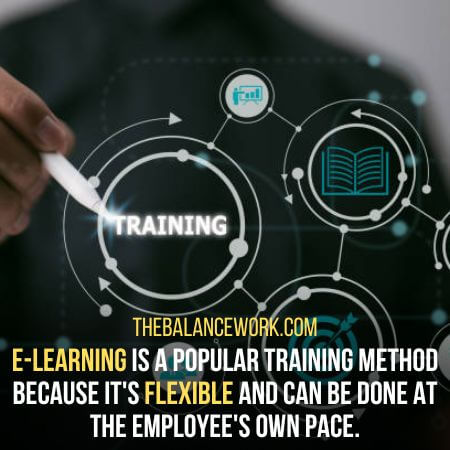You might be wondering how to train a coworker. After all, you want them to be able to do their job well. And you don’t want to deal with them making mistakes constantly.
Training a coworker can be difficult, but it’s important to remember that everyone learns differently.
How To Train A Coworker In 4 Steps
Some people learn better by watching others, while others learn better by doing things themselves.
There is no one right way to train a coworker. However, there are a few tips that can help you get started:
1. Use Different Training Methods:
As mentioned above, not everyone learns in the same way. Some people learn better by watching others. While others learn better by doing things themselves.
Therefore, it’s essential to use different training methods. Here are some other training methods that you can use:
1.1 On The Job Training:
One of the best ways to train a coworker is to let them shadow you or another employee.

This way, they can see how the job is usually done and ask questions if they’re unsure about anything.
On-the-job training is beneficial for complex tasks that require a lot of steps.
It includes :
– Induction training:
This is the training you give to a new employee when they start working for you.
For instance, you might show them how to deal with customer inquiries.
– Job shadowing:
It is where an employee shadows another employee to learn how to do their job.
For instance, if you’re training a new customer service assistant. They might shadow someone who’s been working in customer service for a while.
– Apprenticeships:
An apprentice is someone employed to learn a trade from another person. Other person is already qualified in that trade.
Apprenticeships usually last for one to four years. And the apprentice will usually get salary for their work.
– Task-specific training:
This is training that’s specific to a particular task. For instance, you might give your employees training on how to use a new piece of software.
– Probationary training:
This is the training you give to employees during their probationary period.
For instance, you might give them extra coaching in their first few months of employment.
– Refresher training:
This is the training you give employees to refresh their skills.
For instance, you might give them a refresher course on customer service. If introducing a new customer service system.
1.2 E-Learning:
E-learning is training delivered using electronic media. Such as the internet, CDs, or DVDs.
It’s a popular training method because it’s flexible and can be done at the employee’s own pace.
E-learning can be used for a wide range of training. It can include induction training, task-specific training, and refresher training.

And some popular e-learning platforms are:
– Moodle: Moodle is a free, open-source learning platform.
– Blackboard: Blackboard is a commercial learning platform many universities and colleges use.
– Articulate: Articulate is a commercial e-learning authoring tool.
1.3 Classroom Training:
Classroom training is where the trainer and trainees are in the same room.
It’s a popular training method. It allows face-to-face interaction between the trainer and trainees.
It includes:
– Seminars:
A seminar is an educational event where a speaker lectures a group of people on a particular topic.
For instance, you might hold a seminar on customer service for your employees.
– Workshops:
A workshop is an educational event where participants work on a particular task or project.
For instance, you might hold a workshop on how to use a new piece of software.
– Conferences:
A conference is an educational event. Here experts from a particular field give presentations to an audience.
For instance, you might attend a conference on customer service.
– Webinars: A webinar is a type of educational event that’s held online.
For instance, you might hold a webinar on customer service.
1.4 Blended Learning:
Blended learning is a type of training that combines classroom training with e-learning.
It’s a popular training method because it combines the best of both worlds.
For instance, you can use e–learning to deliver the content. And then use classroom training for the practical elements.
1.5 Coaching and Mentoring:
Coaching is a type of training where the trainer gives the trainee specific guidance.
Mentoring is training where the trainer gives the trainee general guidance and advice.
Both coaching and mentoring are popular training methods. They’re personalized and tailored to the needs of the trainee.
And when done right, they can lead to positive outcomes. Such as improved performance and increased motivation.
2. Design A Training Course Outline:
Once you’ve decided on the type of training, you need to design a learning outline. Here are some tips:
2.1 Set Clear Objectives:
Before you start training your coworker, it’s essential to have a clear idea of what you want them to learn.
Write down specific objectives and ensure they understand what is expected of them.

When setting objectives, it can be helpful to use the S.M.A.R.T goal-setting method:
– Specific: The objective should be clear and specific.
– Measurable: The objective should be something that you can measure.
– Achievable: The objective should be something your coworker can realistically achieve.
– Relevant: The objective should be relevant to the job they are being trained for.
– Timely: The objective should have a specific time frame.
2.2 Choose The Appropriate Materials:
Once you’ve set the objectives, you must choose the appropriate materials. This will depend on the type of training you’re doing.
For instance if you’re doing e-learning, choose an e-learning platform. And then create the course.
The materials you need will also depend on the objectives you’ve set.
For instance, if your objective is to train your coworker on how to use new software. You’ll need to provide them with the software and a manual.
And if your objective is to improve their customer service skills. You might provide them with a customer service manual.
If you’re doing classroom training, provide them with materials. Such as a workbook or handouts.
2.3 Decide On The Length Of The Training:
The length of the training will also depend on the type of training you’re doing.
For instance, if you’re doing e-learning, the course might be self-paced. It means that your coworker can complete it at their own pace.
The sessions might be one hour long if you’re doing classroom training.
And if you’re doing a webinar, the session might be two hours long. So depending on the type of training, you’ll need to decide on the length.
And when you’re designing the training, keep the attention span of your coworker in mind.
For instance, if you’re doing e-learning, break the course into smaller modules.
And if you’re doing classroom training, have shorter sessions with breaks between.
2.4 Choose The Right Trainer:
Choosing the right trainer is essential to the success of the training.
The trainer should be knowledgeable and experienced in your training topic. And they should also be able to communicate effectively.

If you’re doing classroom training, choose a trainer who is interactive and engaging.
And if you’re doing e-learning, choose a trainer who can give clear instructions.
3. Deliver The Training:
Now that you’ve designed the training, it’s time to deliver it. To provide the training, you’ll need to:
3.1 Classroom Training:
If you’re doing classroom training, there are a few things you need to do to prepare all the materials you need.
You’ll need to print out the materials. Such as the workbook, handouts, and PowerPoint slides.
And you’ll need to set up the room, such as the chairs and projector. To break the ice, you might want to start with an icebreaker.
This fun activity will help your coworkers get to know each other and feel more comfortable.
Some examples of icebreakers are:
– Two Truths And A Lie:
Each person says three things about themselves, two of which are true, and one is a lie. The others have to guess which one is the lie.
– Human Bingo:
You give each person a sheet of paper with different questions, such as “Have you ever been skydiving?” or “Do you have any siblings?”.
And they have to find someone who can answer yes to each question.
Then you can introduce the training by explaining what they will be learning. And why it’s essential.
After that, you can start the first activity. And throughout the session, you should be facilitating and leading the discussion.
You can do this by asking questions and providing feedback.
3.2 E-learning:
If you’re e-learning, you must ensure that your coworker can access the course.
You can do this by sending them a link to the course or by adding them to the course in your learning management system.

Then you can introduce the course by explaining what they will be learning and why it’s essential.
After that, you can start the first activity. And throughout the course, you should be providing feedback.
4. Asses The Training:
After the training, assess how well your coworker understood the material.
You can give them a test or ask them to complete a project.
This will help you to see what areas they need to improve on. And what areas they excelled in.
It’s also essential to get feedback from your coworker on the training itself.
You can do this by sending them a survey or by asking them for a one-on-one meeting.
This feedback will help you to improve the training for future employees.
So here are a few things to remember when designing and delivering training to your coworker.
By following these tips, you can ensure that your coworker will be able to learn the material. And they could put it into practice.
Final Word:
Training your coworker doesn’t have to be much complicated. You can start with these tips on designing and delivering the training.
And then, you can customize the training to fit your needs. With a little effort, you can ensure that your coworker can learn and put the material into practice.
Last Updated on 1 hour by Shahzaib Arshad
- Why Does My Boss Wink At Me? 6 Potential Reasons - October 5, 2023
- Is It Legal For Your Employer To Call Your Doctor? No, But… - October 4, 2023
- 12 Ways To Deal With A Low IQ Person - September 22, 2023